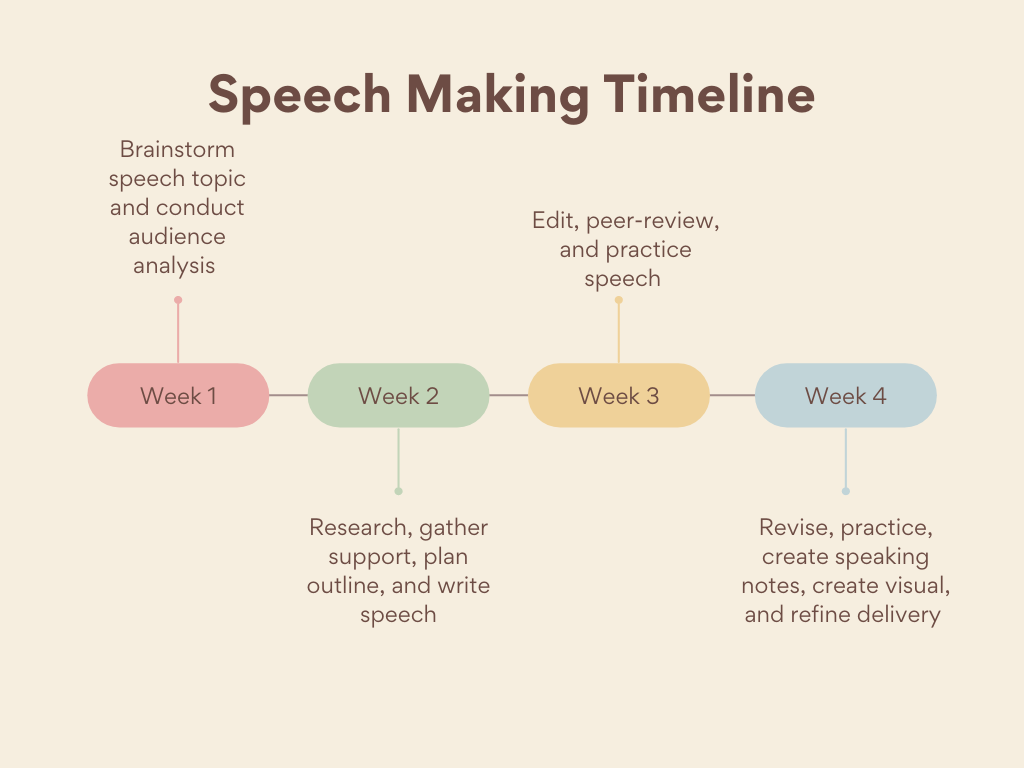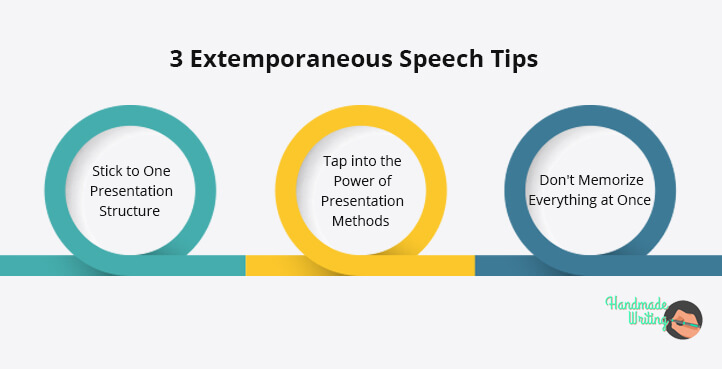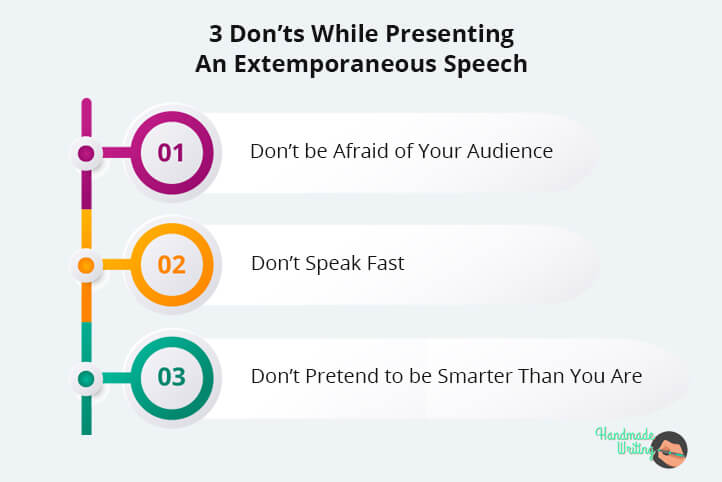
Ace the Presentation


Extemporaneous Presentation: Definition and Actionable tips
There are several forms or methods of speech delivery out there and it can be impromptu (with no warning, more improvisation required), or the most common case: extemporaneous presentations.
EXTEMPORANEOUS PRESENTATION DEFINITION
We need to define this properly and make sure people don’t get confused here. Because from a literal sense extemporaneous and impromptu have the same exact meaning, the difference being that extemporaneous is an older term, both mean out of time, without preparation, ad-hoc, etc .
Now, here’s the tricky thing: From a dictionary point of view, they’re one and the same, but in the art/science of public speaking, they are taught as different things.
Extemporaneous, which comes from Latin ex tempore (“out of the time”), joined the English language sometime in the mid-17th century. The word impromptu was improvised soon after that. In general usage, extemporaneous and impromptu are used interchangeably to describe off-the-cuff remarks or speeches, but this is not the case when they are used in reference to the learned art of public speaking. Teachers of speech will tell you that an extemporaneous speech is one that has been thoroughly prepared and planned but not memorized, whereas an impromptu speech is one for which absolutely no preparations have been made.
Merriam Webster Dictionary
In Short: an extemporaneous presentation is a form of speech delivery where the speaker is notified with some antecedence that he/she will be presenting, giving an opinion, or sustaining arguments about a particular subject, and usually, he/she prepares for it and brings some keynotes.
Here the speaker has time to prepare himself, he can have some notes as a reminder with him, but the audience does not expect them to be read. The speaker has to be spontaneous and deliver the speech with the soul, a more formal way of speaking because it is carried out using notes.
Related Articles:
Impromptu Speech Topics and Tips
Memorized Speech or Presentation
The 4 Types of Speech Delivery
Extemporaneous Presentation or Speech Tips
This speech delivery method is significant because it follows the outline that usually comes from the notes we take; most of them come from our personal experience and research.
Even if we have a full manuscript or tons of notes, memorizing the speech is a bad idea the audience expects us to be prepared and know what we talk about, yet when we show up, our heart has the speak up.
One key thing that makes or breaks your extemporaneous presentation is the lack of planning, research, outlining, mastering the topic.
The extemporaneous presentation can happen in situations such as:
- A business meeting or negotiation;
- When delivering a press conference or an interview;
- A school presentation;
- A graduation or birthday speech;
- A political debate.
- A Training session with your Team at Work
Let’s take this last scenario as an example…
Extemporaneous Presentation Example & Actionable Tips
Training Your Sales Team About a New Product

Say you have to deliver a 2hr training session to your sales team about the launch of a new product in the next 3 days
As we mentioned above, having a decent amount of background knowledge allows us to discuss any topic or question that can pop up from the audience.
A) Planning and Preparing an Extemporaneous Speech
- Research all you can about the new product, the place where the training will take place, and the target customers of that product.
- Prepare your Presentation Outline, based on key findings and most critical needs identified
- Fill out the Deck or Slideshows with some of the pointers /features/pictures/or any relevant info about the product
- Highlight the Pitch to be used to Convert many prospects
- To connect with the audience and build engagement prepare a small session where the trainees can rehearse the pitch
- Make sure you know your slides and the topic well enough to answer most questions fired at you
- , and iterate on them for the next one
B) Delivering an Extemporaneous Speech
- ! It goes without saying that the opening of the speech or presentation is key to making an impact on your audience. Here, it could be something as simple as the results of your audience research and the astounding findings on the potential of sales…or, a great sales quote.
- Tell Stories that are Relatable: In your research, you spoke to prospects, and you have got some real-life feedback on the product, and the challenges it may solve. Share those stories with the trainees.
- Engage the Audience: Make sure to ask questions about how the audience feels they could sell the product and the challenges they’d face. Collect feedback and share your own thoughts and findings and ask for their feedback as well.
- Posture and Confidence: You did all the preparatory work, you know your topic, and you really want to share some valuable insights and learnings with the audience. Stand proud of your work, and exude confidence – that builds trust in your teachings.
- Ending an Extemporaneous Presentation: Make sure you voice the trainee’s opinions, summarize them, highlight key learnings, key findings from your research, the expected number of sales, the commissions they’ll earn, and end with a motivational quote on perseverance and success.
Here you have six characteristics of an extemporaneous presentation
- Has a Script / Notes / Teleprompter and it is not expected to be used too much
- Has a Specific topic of discussion
- Delivered with very little notes
- Performed after some preparation
- Practical, clear, and somewhat improvised at times (not sticking to reading notes)
- The speaker has some background knowledge on the topic
It is possible to be ready for surprises and unexpected events, in this case.
An extemporaneous presentation if we make our daily steps by choosing activities like reading, and surround ourselves with wise and creative people with helping us in a future extemp presentation.
If you read this article until the end, thank you so much for the attention hope you enjoy it.
References and Further Reading
9+ Extemporaneous Speech Examples
How to Deliver an Extemporaneous Presentation or Speech
Extemporaneous
Similar Posts

Common Speech Starting Transitions: Without Further Ado!
You’re taking your steps onto the stage. There’s a room full of people looking at you, all eyes fixated on your entrance. You can hear your heart thumping in your chest. They watch in anticipation, waiting for the first words to come out of your mouth. And that’s when you realize – what do you…

Types of Signposting: 10 Examples of Signposts in Speech
signposts in speech

An Engaging Business presentation? Read This!
You find yourself spending endless hours in tools like Microsoft Teams or Zoom or around a table discussing strategic agendas, busy schedules from beginning to end of the day with conversations about different projects. All this, not infrequently, leaves you exhausted. However, it doesn’t have to be that way! The problem, mind you, is not…

5 Great Tips on How to Become a Motivational Speaker
There a lot of people pondering and wondering. How do I become a motivational speaker? What steps do I take? I want to inspire people? How do I do it? I wish I could speak eloquently and help people, how do I go about becoming a great role model, an inspiration for others? How to…

5 Disadvantages of Memorized Speech
One of the most compromising situations a person can find themselves in is sitting in front of an audience and realizing that they have suddenly forgotten the speech they were going to give. The most embarrassing thing is perhaps stuttering, struggling to remember the thread of the address, searching for words with difficulty, as if…

The 4 Methods or Types of Speech Delivery
On a daily basis, people use several types of speech delivery to connect with others, influence decisions, and motivate change without realizing which occasions a specific method of speech delivery should be used. Today we will talk about 4 types of speech delivery that are commonly used and sometimes happen almost unnoticed. Manuscript Speech Memorized…
- More from M-W
- To save this word, you'll need to log in. Log In
extemporaneous
Definition of extemporaneous
Did you know.
Extemporaneous , which comes from Latin ex tempore ("out of the time"), joined the English language sometime in the mid-17th century. The word impromptu was improvised soon after that. In general usage, extemporaneous and impromptu are used interchangeably to describe off-the-cuff remarks or speeches, but this is not the case when they are used in reference to the learned art of public speaking. Teachers of speech will tell you that an extemporaneous speech is one that has been thoroughly prepared and planned but not memorized, whereas an impromptu speech is one for which absolutely no preparations have been made.
- down and dirty
extemporary
- improvisational
- off-the-cuff
- spur-of-the-moment
- unconsidered
- unpremeditated
- unrehearsed
Examples of extemporaneous in a Sentence
These examples are programmatically compiled from various online sources to illustrate current usage of the word 'extemporaneous.' Any opinions expressed in the examples do not represent those of Merriam-Webster or its editors. Send us feedback about these examples.
Word History
Late Latin extemporāneus "done on the spur of the moment" (from Latin ex tempore "on the spur of the moment, extempore " + -āneus, suffix forming adjectives from temporal adverbs) + -ous
Note: Regarding the suffix -āneus see the etymology and note at spontaneous .
1673, in the meaning defined at sense 1a(1)
Articles Related to extemporaneous

Challenging Words You Should Know Vol 2
It isn’t linguistic hubris if you can back it up
Theme music by Joshua Stamper ©2006 New Jerusalem Music/ASCAP
Get Word of the Day delivered to your inbox!
Dictionary Entries Near extemporaneous
extemporaneity
Cite this Entry
“Extemporaneous.” Merriam-Webster.com Dictionary , Merriam-Webster, https://www.merriam-webster.com/dictionary/extemporaneous. Accessed 19 Apr. 2024.
Kids Definition
Kids definition of extemporaneous, more from merriam-webster on extemporaneous.
Nglish: Translation of extemporaneous for Spanish Speakers
Subscribe to America's largest dictionary and get thousands more definitions and advanced search—ad free!

Can you solve 4 words at once?
Word of the day.
See Definitions and Examples »
Get Word of the Day daily email!
Popular in Grammar & Usage
Your vs. you're: how to use them correctly, every letter is silent, sometimes: a-z list of examples, more commonly mispronounced words, how to use em dashes (—), en dashes (–) , and hyphens (-), absent letters that are heard anyway, popular in wordplay, the words of the week - apr. 19, 10 words from taylor swift songs (merriam's version), a great big list of bread words, 10 scrabble words without any vowels, 12 more bird names that sound like insults (and sometimes are), games & quizzes.

Oratory Club
Public Speaking Helpline
What Is An Extemporaneous Speech?
If you’ve ever wondered, “What is an extemporaneous speech?” you’re in the right place! In this article, we’ll dive into the exciting world of extemporaneous speaking and discover what makes it a unique and thrilling form of communication. So, buckle up and get ready for an adventure in public speaking that’s going to blow your socks off!
Picture this: you’re standing in front of a crowd, your heart pounding with anticipation. The spotlight is on you, and you have limited time to come up with a persuasive and cohesive speech on a given topic. That’s what an extemporaneous speech is all about! It’s a thrilling challenge that tests your ability to think on your feet and deliver a compelling message without the luxury of extensive preparation.
But don’t fret! Extensive preparation doesn’t mean you’re left hanging in the wind. In fact, extemporaneous speakers use a variety of skills, such as critical thinking, research, and organization, to craft their speeches on the spot. So, if you’re ready to unleash your inner orator and captivate audiences with your spontaneous wit and charm, let’s dive deeper into the world of extemporaneous speaking!

Table of Contents
Understanding Extemporaneous Speech: A Guide to Spontaneous Expression
Welcome to our comprehensive guide on extemporaneous speech! Whether you’re a seasoned public speaker or just starting out, understanding what an extemporaneous speech is and how to deliver one effectively is crucial. In this article, we will explore the definition of an extemporaneous speech, its components, benefits, and provide tips for delivering an impressive extemporaneous speech. So, let’s dive right in!
What is an Extemporaneous Speech?
An extemporaneous speech is a type of public speaking that requires speakers to present a well-researched and organized speech on a given topic without extensive preparation or a fully written script. Unlike a scripted speech, where every word is written beforehand and memorized, an extemporaneous speech allows speakers to use notes or prompts for guidance while delivering their presentation.
Extemporaneous speeches are commonly used in academic settings, such as debates, competitions, and classroom presentations. They test the speaker’s ability to think on their feet, organize their thoughts quickly, and deliver a coherent and persuasive argument or message. Extemporaneous speaking combines elements of impromptu speaking and prepared speeches, striking a balance between spontaneity and structure.
One of the key aspects of an extemporaneous speech is the delivery style. Speakers should aim to maintain a conversational tone, engage the audience, and connect with them authentically. While some level of preparation is allowed, the main goal of an extemporaneous speech is to demonstrate critical thinking skills, adaptability, and effective communication.
The Components of an Extemporaneous Speech
Before diving into the process of delivering an extemporaneous speech, let’s take a closer look at its essential components:
- Preparation: While an extemporaneous speech is not fully scripted, it still requires some level of preparation. Speakers should gather information on the given topic, research relevant data, and formulate key points or arguments. This step ensures that the speech is well-informed and coherent.
- Structure: An extemporaneous speech typically follows a basic structure, including an introduction, body, and conclusion. The introduction should grab the audience’s attention, introduce the topic, and provide a clear thesis statement. The body should consist of main points supported by evidence, while the conclusion should summarize the key ideas and leave a lasting impression.
- Delivery: As mentioned earlier, the delivery of an extemporaneous speech should be conversational and engaging. Speakers should maintain eye contact with the audience, use appropriate gestures and body language, and speak clearly and confidently. It is important to strike a balance between sticking to the main points and allowing flexibility in responding to the audience’s reactions.
Tips for Delivering an Impressive Extemporaneous Speech
Now that we have a basic understanding of what an extemporaneous speech entails, let’s explore some tips for delivering an impressive extemporaneous speech :
- Practice active listening: Engage in active listening to absorb information and gather different perspectives on the given topic. This will enable you to develop a well-rounded and informed speech.
- Understand the audience: Consider the demographics, interests, and knowledge level of the audience. Tailor your speech to resonate with them and address their specific needs or concerns.
- Organize your thoughts: Utilize note-taking techniques, such as mind maps or bullet points, to organize your thoughts and maintain a clear structure during your speech.
- Practice improvisation: Embrace impromptu speaking opportunities to enhance your ability to think on your feet and respond to unexpected questions or challenges.
- Focus on body language: Pay attention to your body language, facial expressions, and vocal tone. Maintain a confident posture, make eye contact with the audience, and use gestures to emphasize your points.
- Engage the audience: Make your speech interactive by asking questions, incorporating storytelling, or inviting the audience to participate. This will create a dynamic and memorable experience.
- Reflect and learn: After delivering your extemporaneous speech, take the time to reflect on your performance. Identify areas for improvement, seek feedback from others, and continue refining your skills.
Benefits of Mastering Extemporaneous Speaking
Moving beyond the basics, let’s explore some of the benefits of mastering extemporaneous speaking :
1. Enhanced Communication Skills
Extemporaneous speaking hones your ability to articulate ideas clearly, engage with an audience, and adapt your message based on their reactions. This translates into improved communication skills that are valuable in various personal and professional scenarios.
2. Critical Thinking and Problem-Solving
Delivering an extemporaneous speech requires quick thinking, analyzing information, and developing logical arguments on the spot. By regularly practicing this skill, you’ll strengthen your critical thinking and problem-solving abilities.
3. Confidence Building
As you become more adept at delivering impromptu speeches, your self-confidence will grow. The ability to express yourself confidently and coherently in front of an audience can boost your self-esteem and positively impact other areas of your life.
Mastering Extemporaneous Speaking: A Lifelong Journey
Now that you have the knowledge and tips to deliver an impressive extemporaneous speech, it’s time to embark on your journey of mastering this valuable skill. Remember, extemporaneous speaking requires practice, patience, and a willingness to step out of your comfort zone. Embrace each speaking opportunity as a chance to grow and learn, and soon you’ll be captivating audiences with your well-crafted and spontaneous speeches. Happy speaking!
Key Takeaways: What is an Extemporaneous Speech?
- An extemporaneous speech is a speech that is delivered without extensive preparation.
- It allows the speaker to effectively communicate their ideas in a spontaneous and natural manner.
- This type of speech is commonly used in competitions or public speaking events.
- Key skills for delivering an extemporaneous speech include good organization, clear articulation, and the ability to think on your feet.
- Practicing and familiarizing yourself with different topics can help improve your extemporaneous speaking skills.
Frequently Asked Questions
Welcome to our frequently asked questions section where we’ll answer common inquiries about extemporaneous speeches. Whether you’re a student preparing for a school assignment or an aspiring public speaker, we’ve got you covered. Discover the ins and outs of extemporaneous speaking below.
1. How would you define an extemporaneous speech?
An extemporaneous speech is a type of impromptu presentation where the speaker delivers a prepared speech without relying on a script or memorized content. It requires the speaker to think on their feet and express their thoughts and ideas in a clear, concise, and organized manner. Rather than being fully spontaneous, an extemporaneous speech involves some level of preparation, research, and organization. This type of speaking encourages adaptability and quick thinking.
Extemporaneous speeches are often given in educational settings, competitions, or professional environments. They help develop skills such as critical thinking, effective communication, and the ability to convey complex ideas in a limited amount of time.
2. How does an extemporaneous speech differ from other types of speech?
An extemporaneous speech differs from other types of speeches, such as impromptu speeches, scripted speeches, or memorized speeches, in several ways. Unlike an impromptu speech, which is delivered with little to no preparation, an extemporaneous speech involves some level of prior research and organization. It allows speakers to gather information and structure their thoughts before stepping up to deliver their speech.
On the other hand, a scripted speech is one that is completely written out beforehand, while a memorized speech is fully memorized and recited word-for-word. In contrast, an extemporaneous speech requires the speaker to have a general idea of what they want to say but allows for flexibility and adaptation while delivering the speech.
3. What are the benefits of delivering an extemporaneous speech?
Delivering an extemporaneous speech offers several benefits. Firstly, it helps develop critical thinking skills as speakers must quickly analyze information and construct their arguments in a coherent manner. It also enhances public speaking skills by encouraging improvisation, adaptability, and engagement with the audience.
Extemporaneous speaking can also boost self-confidence as speakers learn to trust their knowledge and ability to convey ideas without relying on a script. Additionally, it helps improve research skills and the ability to synthesize information into a persuasive speech. Overall, the benefits of delivering an extemporaneous speech extend beyond the realm of public speaking and can be applied to various areas of personal and professional development.
4. What are some tips for delivering an effective extemporaneous speech?
To deliver an effective extemporaneous speech, it’s essential to focus on a few key tips. Firstly, practice impromptu speaking regularly to develop quick thinking and organization skills. Additionally, familiarize yourself with current events and gather knowledge on various topics to have a broader pool of information to draw from during your speech.
When delivering the speech, maintain eye contact with the audience, use confident body language, and vary your tone and pace to keep the listeners engaged. Structure your speech with a clear introduction, main points, and a concise conclusion. Finally, practice time management to ensure your speech fits within the allotted timeframe.
5. Can anyone become proficient in delivering extemporaneous speeches?
Absolutely! With practice and perseverance, anyone can become proficient in delivering extemporaneous speeches. The key is to start by gradually building your skills. Begin by practicing impromptu speaking in a supportive environment with friends or family members. As you gain confidence, challenge yourself by participating in public speaking events or competitions where you can receive constructive feedback.
Engage in activities that enhance critical thinking, such as reading extensively and staying informed about current events. Seek opportunities to speak in front of others, whether it’s in school, community events, or professional settings. Remember, becoming proficient in extemporaneous speaking is a journey that requires patience and a willingness to learn from both successes and failures.

How to Deliver an Extemporaneous Presentation or Speech
So, now you know what an extemporaneous speech is! It’s a speech you make without a script or memorizing everything. You get a topic and a little time to prepare, and then you speak from what you already know. It’s a great way to practice thinking on your feet and sharing your ideas with others. Just remember to stay calm, be confident, and have fun with it!
In an extemporaneous speech, you need to organize your thoughts, use examples to support your ideas, and speak clearly and confidently. Don’t stress too much about being perfect – the important thing is to connect with your audience and share your knowledge. So next time you have to give an extemporaneous speech, remember the tips and techniques we’ve discussed, and go out there and shine!
Similar Posts
What are the important aspects of public speaking.
Important aspects of public speaking include preparation, delivery, body language, and connecting with the audience. Public speaking is a valuable skill that can help you effectively communicate your ideas, influence others, and create a lasting impact. Whether it’s giving a speech, conducting a presentation, or participating in a panel discussion, being able to confidently and…
What are President Obama’S Favorite Public Speaking Tricks?
President Obama’s favorite public speaking tricks include using rhetorical devices, engaging storytelling, and employing strategic pauses for emphasis. Understanding President Obama’s Favorite Public Speaking Tricks President Obama’s favorite public speaking tricks include effective use of storytelling, incorporating humor, and utilizing strategic pauses for emphasis and impact. He also focuses on maintaining eye contact, using authentic…
How Can I Make Use of My Public Speaking Talent in Business?
Public speaking talents can be leveraged in business by delivering effective presentations and engaging with audiences to convey key messages and build relationships, ultimately leading to networking opportunities and enhanced professional reputation. In today’s competitive business world, the ability to effectively communicate and connect with others is invaluable. With strong public speaking skills, individuals can…
What Are The Merits And Demerits Of Extemporaneous Speech?
What are the merits and demerits of extemporaneous speech? If you’ve ever found yourself standing in front of an audience, heart racing, trying to deliver a speech without a script, then you’ve experienced the thrill and challenge of extemporaneous speaking. In this style of public speaking, you rely on your knowledge, confidence, and ability to…
Public Speaking Without Fear
Do you ever get butterflies in your stomach when you have to speak in front of a crowd? Don’t worry, you’re not alone. Public speaking without fear is a skill that many people aspire to master. And guess what? It’s totally within your reach! In this article, we’re going to explore some strategies and techniques…
How to Get Public Speaking Jobs?
To get public speaking jobs, define your area of expertise and target audience, gain public speaking skills, learn the art of speech writing, create a professional online presence, start with local events, and attend networking engagements. Also, consider joining relevant interest groups and reaching out to venues. Credit: www.heavenlyspeaking.com Identifying Your Expertise And Target Audience…
Extemporaneous Speech – Definition, Tips, List of 100 Topics.
24 May, 2020
15 minutes read
Author: Mathieu Johnson
Do you belong to that type of people who fear to speak on education topics in public? Then check our list of extemporaneous speech topics to get yourself started.

Definition of Extemporaneous Speech

What is an extemporaneous speech you may ask? The essence of this type of speech lies in answering the question in a school assignment or tournament in front of the audience. In comparison to impromptu speech that requires zero time for topic preparation, extemporaneous speaking does allow us to take some time and take notes before entering the stage.
While giving a speech looks like a terrifying task, the art of extemporaneous delivery is not that hard to master. After all, there is a reliable essay writer , that can provide you with a brilliant text if you don’t know how to write an extemporaneous speech.
Extemporaneous Speech Tips

Stick to One Presentation Structure
For those who don’t know what is extemporaneous delivery – the answer is simple. It’s a natural ability to speak on a topic without or with little preliminary preparation for a speech. The best way to develop your extemporaneous style is to use a solid structure, like the SEE one. The abbreviation stands for statement, evidence, and emotion. This scheme is a useful tool for you to utilize when you need to speak extemporaneously during a speech. For example, when you’re asked to speak on your recent class project in an extemporaneous speech, divide your answer into blocks. First, provide a statement that tells about your success on the project. Then, give some evidence of your hard work on the task to back up your initial statement. Finally, appeal to emotion by sharing an interesting story associated with the project.
Tap into the Power of Extemporaneous Presentation Methods
There might be situations when you’ll feel uncomfortable speaking to a large – or not very – number of people. Your audience will sense this inner tension during the speech unless you find a way to maintain communication with them. One of the time-proven means of delivering an excellent speech is to be kind and speak nicely. Keep eye contact with people you talk to, smile naturally, and visually scan the audience to make them feel that you’re confident. Another great trick to use in case of confusion or oblivion during an extemporaneous speech is to create an intentional pause whenever you forget the text. This way, you’ll heat the interest of listeners for your speech even more.
Don’t Strive to Memorize Everything at Once
Learning texts by heart is a great practice anytime, except when it comes to giving an extemporaneous speech. Memorizing everything you want to pronounce in front of the audience will only distract you from what’s important – the message you want to speak on. You’ll only want to remember words from the notes instead of focusing on the essence of your speech.
Extemporaneous speaking is a skill that requires the ability to engage listeners to the topic and naturally discloses the idea with the mighty power of words. With little practice and devotion, you can make listeners genuinely interested in your personality and your manner of presenting any subject. If you have struggles defining your topic or keep asking “ can someone write my speech ?”, there are writing services that are ready to help. Stay confident, forget about fear, and strive to deliver the most memorable extemporaneous speech ever.
How to Prepare for Your Next Extemporaneous Speech in 3 Steps?

Step 1 – Think of Your Topic
Before the speech starts, you will, in most cases, be given a subject to speak about. At this point, it’s more than important to choose the topic for a speech which is closer to you, or which you have a burning desire to speak on with others. Whether it’s connected with controversial issues or even socially disturbing ones, choose wisely and confidently.
Step 2 – Develop a Thesis Statement
A thesis is an essential element of any writing or speech piece. It’s a form of instruction that helps speakers better swim in the ocean of thoughts that spring to mind with regard to this or that extemporaneous speech topic. Write down, in two-three short sentences, what your feelings and opinions about the issue are. Then, reread your thesis and add some more information to speak about if necessary.
Step 3 – Practice in Advance
The practice is the key to success in any situation, and especially in cases when you’ll need to give an extemporaneous speech. Start with something as simple as speaking to yourself in the mirror. Try to observe the manner you speak, the body language you use, and if there are blind spots, fill them with more practice to avoid such mistakes. Alternatively, consider recording yourself to evaluate how good you speak and how decent your articulation is. Keep training until you are satisfied with the result.
3 Things You Should Not do While Presenting Your Extemporaneous Speech

Don’t be Afraid of Your Audience
Your palms are probably sweating as you try to imagine how others will judge you or make premature conclusions when you speak to them during a speech. In reality, it’s just a delusion that lives in your head. Try to relax and enjoy the experience of being listened to.
Don’t Speak Fast
The human brain always needs some to process the information it receives while you speak. Accelerated speech makes it harder for listeners not only to digest your ideas but also to figure out what you want to say. To get away with nerves and calm down, it’s always a good idea to take a deep breath before you start an extemporaneous speech.
Don’t Pretend to be Smarter Than You Are
Many speakers make a huge mistake when they try to be experts in the topic, when in fact they’re not. Such an attitude to an extemporaneous speech will only diminish the trust of your audience that will otherwise detect your false intentions. Hence, be sincere with the public you speak to and take a personal stance on any topic you discuss during a speech .
Extemporaneous speaking is a skill that requires the ability to engage listeners to the topic and naturally discloses the idea with the mighty power of words. With little practice and devotion, you can make listeners genuinely interested in your personality and your manner of presenting any subject. If you have struggles defining your topic or keep asking “can someone write my speech?”, there are writing services that are ready to help. Stay confident, forget about fear, and strive to deliver the most memorable extemporaneous speech ever.

To facilitate your work on a speech, we’ve prepared a list of 100 speech topics on a wide range of disciplines that’ll guide you in the right direction.
List Of 100 Speech Topics.
- How can unequal conditions for different social classes be combated?
- Should people be restricted by social rules and ethical codes, and why?
- How has the environmental pollution worsened our quality of life?
- Speak on why is apathy about politics more widespread now than in past decades?
- Should the government constantly encourage people to convert waste into reusable material?
- How can you foster environmental responsibility in your community?
- What environmental issue keeps menacing the environment in America?
- Tell us about yourself, and share some unusual trait that you have
- Speak on the best day of your life. How did you feel then and why?
- Tell the class about where you see your life in 10 years
- Describe the ten best things you like about your city
- What are the ten things you dislike about your school/ college?
- An incident of your bravest act
- A story from my life with a lesson and a message
- Speak about who is your favorite author, and why?
- Present a word portrait about one of your friends
- Recall on the time when you had to give honest feedback
- What is one thing that you think will make you successful?
- Speak on a person who motivates you
- Why do people celebrate Thanksgiving?
- Why is Paris a unique place for traveling to?
- What television show you think should be canceled, and why?
- Speak on what is the best way to combat internet crime and piracy
- Will the problem of water supply be the top geopolitical problem we will be ought to resolve?
- Can workers do anything to resist automation?
- Is big tech eroding American concerns about personal privacy?
- Speak on your biggest concern for the future
- Real wealth is never measured in money, what do you think about it?
- How do you see the killing of animals that keep happening all over the world to produce food or other leather materials?
- Do you believe in fate/ destiny?
- What is the most useless invention do you think?
- If you got a chance to choose between born as a boy or a girl, which one do you prefer?
- Speak on how important communication is to you?
- What is more important – skills or education?
- Beauty is always in the eye of the beholder, do you agree with it?
- If you were extremely rich, what would you do with your money?
- What goes around comes around, how would you explain it?
- If you were a president, what would you do?
- Do you want to live in a kingdom? Why?
- If you could choose a country to live in, what country would it be?
- Describe the happiest moment in your life
- If you were an animal, what kind of animal do you want to be?
- What could we do to save the earth?
- Speak on why is it important to learn a second language
- Should exams be replaced by other forms of testing performance?
- Tell us what can we do to increase our patience?
- How can world peace be achieved?
- Every change should start with the man in the mirror, do you agree with it?
- What is the meaning of life in the moment for you?
- Should we cherish everything we have?
- Which is more important do you think, being smart or beautiful?
- Do you think the doomsday is real?
- Speak about your favorite family tradition?
- If you were alone on a lonely island, what would you do there?
- How does technology affect our lives?
- Can we reach our goals without working hard?
- What does being fair mean for you?
- Imagine how people will look like in 1000 years.
- Actions speak louder than words, how do you see it?
- Speak on whether smoking should be allowed in public places?
- If your life was a movie, what title would you give it?
- Speak on your biggest fear
- Is it important to have a sense of humor?
- What is your idea of a perfect job?
- Speak about your role model?
- What do you think being educated means?
- Is it necessary to make plans before doing something?
- Conservation is survival, do you agree with this statement?
- What’s the hardest thing you’ve ever done?
- All that glitters is not gold, explain it
- If you had a chance to invent something useful, what would it be?
- If you knew you only had 24 hours left to live, what would you do?
- What does a family mean for you?
- Speak on your idea of a perfect day?
- Speak on whether it is a good idea to be a vegetarian?
- Do you prefer tea or coffee? Why?
- What is the biggest thing you’ve done that you’re proud of?
- What do you think is a healthy lifestyle?
- When you go for shopping, which one is more important for you, price or quality?
- People say the biggest challenge in life is discovering who you are, do you agree?
- The world is full of nice people. In your own opinion, are you one of them?
- When you are in a room full of people, do you mostly feel happy or lonely?
- You are what you do, not what you say you will do. Do you agree?
- If you could take a year off from school, what would you do?
- Speak on what do your dreams mean to you
- Explain the meaning of life for you
- Do you think all people are selfish?
- Speak on how can society affect your character
- What are the benefits of homework?
- Could final testing in senior high schools reflect your effort for the past few years?
- Should hunting be illegal?
- Is it right to ban fur clothing?
- Speak on the ways to reduce homelessness
- Should the death penalty be banned?
- Do you think being a leader is easy?
- Speak on what do you think your life purpose is
- How do you start a conversation with a stranger?
- What human quality do we need more of and why?
- What do you miss most from your childhood?
- Will life be better in the next century?

A life lesson in Romeo and Juliet taught by death
Due to human nature, we draw conclusions only when life gives us a lesson since the experience of others is not so effective and powerful. Therefore, when analyzing and sorting out common problems we face, we may trace a parallel with well-known book characters or real historical figures. Moreover, we often compare our situations with […]

Ethical Research Paper Topics
Writing a research paper on ethics is not an easy task, especially if you do not possess excellent writing skills and do not like to contemplate controversial questions. But an ethics course is obligatory in all higher education institutions, and students have to look for a way out and be creative. When you find an […]

Art Research Paper Topics
Students obtaining degrees in fine art and art & design programs most commonly need to write a paper on art topics. However, this subject is becoming more popular in educational institutions for expanding students’ horizons. Thus, both groups of receivers of education: those who are into arts and those who only get acquainted with art […]

4 Extemporaneous Speaking: The Basics
Learning Objectives
- Demonstrate an understanding of proper speech delivery by learning the key elements of extemporaneous speaking and the time it will take to deliver the well-developed speech.
Extemporaneous Speaking
Extemporaneous speaking is a fancy way of saying: delivering a well-prepared speech. Extemporaneous speaking is not delivering a monologue or a memorized speech. Public speaking students often fall into the trap of under-preparing and under-practicing their speeches. This results in an, “Oh! no! I am not prepared and now I must read this outline word-for-word and hope for the best.” However, the best does not come to fruition and students that engage in this practice are disappointed when they lose substantial points from their speech grade due to lack of preparation, practice, and reading word-for-word from an outline. Just – don’t – do -it.
Here are a few ways you can engage in extemporaneous speaking:
- Know your speech topic
- Research your topic
- Create a timeline – research, writing, peer-review, practicing, editing, practicing again
- Create note cards to guide your speech
- Practice, practice, practice
- connecting with your audience is key in extemporaneous speaking
Dialogue vs. Monologue
The first tenet of the dialogic perspective is that communication should be a dialogue and not a monologue. Lev Yakubinsky argued that even public speaking situations often turn into dialogues when audience members actively engage speakers by asking questions. He even claimed that nonverbal behavior (e.g., nodding one’s head in agreement or scowling) functions as feedback for speakers and contributes to a dialogue (Yakubinsky, 1997). Overall, if you approach your public speaking experience as a dialogue, you’ll be more actively engaged as a speaker and more attentive to how your audience is responding, which will, in turn, lead to more actively engaged audience members.
Build a Proper Timeline
- To ensure you have enough time for the assignment, create a timeline that works for your schedule
- Week 1 – Brainstorm your speech topic and conduct an audience analysis
- Week 2 – Research, gather support, plan outline, and write a speech
- Week 3 – Edit, peer-review, begin practicing your speech
- Week 4 – Revise, practice, create note cards, create a visual aid, and refine your delivery

Building on This Information
As you progress through this course, you will revisit proper extemporaneous speaking, the use of outlining, proper use of notecards, and delivering a strong speech. It is important to note that your audience deserves a speech that is interesting, thoughtful, and well-rehearsed. The audience is listening to you as the credible speaker in the room; in order to remain credible and professional, you will want to deliver an extemporaneous speech.
Key Takeaways
Students will want to become familiar with extemporaneous speaking in order to work towards a speech delivery that relies on effective speech strategies and not reading word-for-word from an outline.
- Extemporaneous speaking is a skill that public speaking students must hone in on before delivering their speech to an audience.
- Students will want to plan ahead to deliver a strong speech in the informative and persuasive speech weeks of this course.
- Creating a proper timeline will assist in delivering a well-developed extemporaneous speech.
Public Speaking Copyright © by Dr. Layne Goodman; Amber Green, M.A.; and Various is licensed under a Creative Commons Attribution-NonCommercial-ShareAlike 4.0 International License , except where otherwise noted.
Share This Book
Speech Writing
Extemporaneous Speech

The Art of Extemporaneous Speech: Mastering the Unexpected
Published on: Apr 14, 2022
Last updated on: Mar 25, 2024

People also read
Good Motivational Speech Topics for Beginners
Commemorative Speech Definition & Complete Writing Guide
Learn How to Write an Acceptance Speech like Experts
Best Impromptu Speech Topics for Public Speaking
Types of Speeches: The Ultimate Guide for Your Next Presentation
How to Write a Speech That Stays With Your Audience
Share this article
Public speaking can be intimidating, especially when you're asked to deliver a speech on the spot. The fear of stumbling over words or losing track of thoughts can cripple even the most confident individuals.
However, there is a powerful technique that can help you overcome these challenges and deliver compelling speeches with ease. It's called Extemporaneous Speaking.
But don't worry, we have got you covered!
In this blog, we will explore the art of extemporaneous speaking. We will provide you with valuable insights, techniques, and tips to master this skill.
Whether you're a student, or someone who simply wants to improve their speaking abilities, this guide is here to help.
So, without further ado, let’s get started.
On This Page On This Page -->
Extemporaneous Speech Definition
Extemporaneous speech, also known as impromptu speaking, is a form of public speaking. It requires delivering a speech on a given topic without prior preparation.
Unlike prepared speeches, extemporaneous speaking tests an individual's ability to think on their feet. They have to present coherent arguments or ideas in a spontaneous manner.
Speakers are typically provided with a topic and given a short amount of time to gather their thoughts before delivering the speech.
This style of speaking is often seen in various settings. This includes competitions, debates, or classrooms.
What are the Elements of an Effective Extemporaneous Speech?
An effective extemporaneous speech incorporates several key elements that contribute to its overall impact and success. Let's explore these elements in detail for this particular type of speech :
Clear Introduction
Begin your speech with a concise and attention-grabbing introduction. Clearly state the topic or question at hand and provide a brief overview of what you'll be discussing. Engage the audience from the start to capture their interest.
Well-Structured Content
Organize your speech into a logical structure that flows smoothly. Use a combination of main points and supporting details to build a coherent and persuasive argument. Consider using techniques like the problem-solution approach, cause-effect analysis, or chronological order, depending on the nature of your topic.
Engaging Delivery
Deliver your speech with energy, confidence, and enthusiasm. Maintain eye contact with the audience, use appropriate gestures and body language, and vary your tone of voice. Aim for a conversational style that connects with your audience on a personal level.
Supporting Evidence
Back up your arguments with relevant and credible evidence. Incorporate statistics, facts, examples, and anecdotes to strengthen your points and provide a deeper understanding of the topic. Use sources such as reputable studies, expert opinions, or real-life experiences to lend credibility to your speech.
Effective Conclusion
End your speech with a memorable conclusion that summarizes your main points and reinforces your thesis statement. Leave the audience with a lasting impression or a call to action, encouraging them to reflect on your speech.
Adaptability
Extemporaneous speaking requires the ability to adapt to unexpected situations or changes in the speaking environment. Be flexible and prepared to adjust your speech as necessary. This may involve addressing counter arguments, responding to audience questions, or incorporating new information that arises during your speech.
How To Deliver An Extemporaneous Speech?
Delivering an extemporaneous speech requires a combination of preparation, confidence, and adaptability. Here are some key tips to help you deliver an effective extemporaneous speech:
Familiarize Yourself with the Topic
Take time to understand the topic or question you'll be speaking about. Research and gather relevant information to develop a solid understanding of the subject matter. This knowledge will give you a foundation to draw upon during your speech.
Structure Your Speech
Create a basic structure for your speech with an introduction, body, and conclusion. Clearly define the main points or arguments you want to address. Organize your supporting ideas in a logical sequence, ensuring a smooth flow from one point to another.

Use Prompts and Keywords
Instead of memorizing your entire speech, use prompts and keywords to guide you through each section. Create cue cards or outline key points on a notecard. This will help jog your memory and keep your speech on track without sounding overly rehearsed.

Tough Essay Due? Hire Tough Writers!
Speak Naturally
Avoid sounding robotic or overly scripted. Aim for a conversational tone that reflects your personality and allows you to connect with the audience. Be mindful of your pacing and avoid rushing through your speech. Speak clearly and enunciate your words to ensure clarity.
Use Visual Aids (if available)
If visual aids such as slides or props are available, utilize them to enhance your speech. Visual aids can provide additional support to your main points and make your presentation more engaging. However, be careful not to rely too heavily on them and maintain the focus on your spoken words.
Handle Nervousness
Feeling nervous is natural, but try to manage your nerves by taking deep breaths and maintaining a positive mindset. Remind yourself of your preparation and expertise on the topic. Channel your nervous energy into enthusiasm and passion for your subject.
Practice Active Listening
During your speech, pay attention to the audience's reactions and engagement. Stay alert to any cues or questions they may have. Adjust your delivery based on their responses, such as slowing down or elaborating on certain points to ensure comprehension.
Be Flexible and Adaptable
Extemporaneous speaking requires adaptability. Be prepared to adjust your speech if needed, such as addressing unexpected questions or incorporating new information. Stay composed and respond thoughtfully to any challenges that may arise.
Seek Feedback and Learn
After delivering your extemporaneous speech, seek feedback from others, such as colleagues, mentors, or trusted individuals. Assess areas of improvement, such as clarity, structure, or delivery. Use the feedback to enhance your skills for future extemporaneous speaking engagements.
How to Make Extemporaneous Speech?
When it comes to writing an extemporaneous speech, the goal is to strike a balance between preparation and spontaneity. A few steps can be followed to write a great extemporaneous speech.
1. Select a Topic
The very first step is selecting a topic. A wise choice would include a topic that you are familiar with. It will take you less time to brainstorm ideas and plan your speech. Take a few minutes to brainstorm all the information you have on the subject.
2. Create an Outline
Draft a quick outline for your speech. It should have a few lines for your introduction, something that the audience can relate to or will find funny, or a question that will alert the audience. Here is a sample outline for you to get a better idea.
Extemporaneous Speech Outline
3. Begin with the Body Paragraphs
After the outline, start working on your body paragraphs. Keep in mind that you do not have a lot of time to write and practice your speech. So make sure that the body paragraph should have a few key points only.
4. Give Examples to Support Your Stance
Continue with your main points by giving some examples. Examples help the audience understand your topic better. It also makes them curious so they might have some questions at the end.
5. Draft a Brief Conclusion
Write your conclusion, but make it very short. If your conclusion is too long it will be redundant for the audience.
Extemporaneous Speech Examples
If you are still struggling to understand how to deliver an extemporaneous speech or how to write it time efficiently, check out these examples mentioned below:
Example of Extemporaneous Speech
Extemporaneous Speech About COVID-19
Extemporaneous Speech Sample
Example of Extemporaneous Speech About Education
Extemporaneous Speech Topics
When it comes to extemporaneous speech topics, the possibilities are vast. Here are some engaging and thought-provoking topic ideas to inspire your impromptu speeches:
- Why do I love playing volleyball?
- When will I become a millionaire?
- Why is Playstation better than Xbox?
- The best songwriter is -fill a name-
- Gays donât have equal rights, is it true?
- Political instability in my country is due to?
- Why is facebookâs popularity falling down so quickly?
- Why are illegal immigrants not given rights?
- Are internet crime and piracy penalized?
- Stopping the war in Afghanistan is important
These are just some of the many extemp speech topics that you can choose from. Feel free to mold these topics according to your knowledge.
If you need more interesting topics, check out our blog on the best Impromptu speech topics for public speaking .
Expert Tips For Delivering An Extemporaneous Speech
Here are some brief tips to help you deliver an extemporaneous speech with confidence and impact:
Know your Audience: Tailor your speech to the specific audience you are addressing to ensure relevance and engagement.
- Practice Impromptu Speaking : Regularly engage in impromptu speaking exercises to sharpen your ability to think on your feet and articulate your thoughts effectively.
- Use Effective Body Language : Use gestures, facial expressions, and body movements to enhance your message and connect with the audience.
- Emphasize Key Points : Highlight important ideas through vocal emphasis, pauses, or repetition to ensure they resonate with your audience.
- Maintain a Steady Pace : Speak at a moderate pace to allow your audience to follow your ideas without feeling rushed or overwhelmed.
- Use Storytelling Techniques : Incorporate anecdotes or stories to make your speech more relatable, memorable, and engaging.
- Be Concise : Keep your ideas succinct and to the point. Avoid unnecessary tangents or rambling, as it can dilute the impact of your speech.
- Practice Active Listening : Pay attention to your audience's reactions and adapt your speech accordingly. Respond to their cues, questions, or feedback to maintain a dynamic and interactive presentation.
- Maintain a Positive Attitude : Approach your extemporaneous speech with a positive mindset. Embrace the challenge, believe in your abilities, and exude confidence in your delivery.
Remember , practice is key to improving your extemporaneous speaking skills.
In conclusion, extemporaneous speaking is a valuable skill that can elevate your public speaking abilities to new heights.
By mastering the art of impromptu speeches, you can deliver compelling presentations in any situation.
Embrace opportunities to practice extemporaneous speaking, whether it's in classrooms, competitions, or professional settings.
The more you engage in impromptu speaking, the more confident and adept you will become. You can try our AI essay writing tools to generate unique speeches and practice!
If you need further assistance with your college essays or any academic writing, CollegeEssay.org is here to help.
Our experienced team of writers can provide expert guidance and support to ensure your essays make a lasting impression.
So what are you waiting for? Just say ' Write an essay for me ' to hire our paper writing service today and take the next step towards achieving your academic goals.
Frequently Asked Questions
How long is an extemporaneous speech.
The length of an extemporaneous speech can vary depending on the specific context or requirements. In general, extemporaneous speeches are typically shorter than prepared or formal speeches. They often range from 5 to 7 minutes, but can sometimes be as short as 3 minutes or extend up to 10 minutes.
What is the difference between impromptu and extemporaneous speech?
The main difference between impromptu and extemporaneous speech is in the level of preparation. Impromptu speeches are delivered on the spot without prior planning or preparation. On the other hand, extemporaneous speeches involve some level of preparation, research, and organization before delivering the speech.
What are two qualities that make up an extemporaneous speech?
Two qualities that make up an extemporaneous speech are spontaneity and organization. Spontaneity refers to the ability to think and speak on the spot.
Organization involves structuring the speech with a clear outline, and cohesive content, ensuring that ideas are effectively communicated.
Caleb S. (Literature, Marketing)
Caleb S. has extensive experience in writing and holds a Masters from Oxford University. He takes great satisfaction in helping students exceed their academic goals. Caleb always puts the needs of his clients first and is dedicated to providing quality service.
Paper Due? Why Suffer? That’s our Job!

Keep reading

Legal & Policies
- Privacy Policy
- Cookies Policy
- Terms of Use
- Refunds & Cancellations
- Our Writers
- Success Stories
- Our Guarantees
- Affiliate Program
- Referral Program
- AI Essay Writer
Disclaimer: All client orders are completed by our team of highly qualified human writers. The essays and papers provided by us are not to be used for submission but rather as learning models only.
How to Deliver an Extemporaneous Presentation
Great speakers typically present in a smooth delivery style that we all admire. They sound like they are having a conversation with listeners rather than talking at them.
This style is called extemporaneous speaking or extemporaneous delivery. That means (a) the speaker knows the material (b) speaks in a conversational style, (c) from limited notes (d) in a structured way.
Listening audiences prefer this style much more than they do listening to a speaker who memorized a presentation word-for-word or a speaker who is reading from overly detailed notes.
In contrast, extemporaneous speaking looks and sounds comfortable and composed. Listeners might assume a conversational style requires special talents. However, any speaker can achieve this with the right preparation.
First, commit to a clear structure. Conversational speakers use a template to prepare their presentations that usually includes a clear introduction, body, and conclusion. Each of these sections has clear component parts. This template gives speakers a mental road map to follow even when they are not looking at their notes.
Second, practice up to 10 times. True, that sounds like a lot but with practice comes comfort. Speakers with that easy conversational look and sound practice many times beforehand to truly internalize the material.
Third, limit your speaking notes to simple phrases or even single words for each idea. The number one killer of conversational delivery is the use of too many notes. More notes leads to more reading and less eye contact. This will almost always prevent a speaker from achieving good delivery. Instead, use a key word outline. Every few times you practice, rewrite your notes and simplify them by cutting the clutter.
Click here to read the rest of Alex’s tips.
Submit a Comment
You must be logged in to post a comment.
This site uses Akismet to reduce spam. Learn how your comment data is processed .
Recent Posts
- What Are You Going to Talk About if You Have a Short Presentation? [VIDEO]
- A Tip to Increase Your Confidence [VIDEO]
- What’s Your 2020 Goal? [VIDEO]
- How to Prepare a Presentation Without a Script [VIDEO]
- How to End a Group Presentation [VIDEO]
- How to Improve School Group Presentations [VIDEO]
- How to Improve Your Presentation Skills With Your Hands [VIDEO]
- Cambridge Dictionary +Plus
Meaning of extemporaneous in English
Your browser doesn't support HTML5 audio
- abrupt halt
- inadvertency
- inadvertent
- inadvertently
- inconceivable
- inconceivably
- spontaneity
- spontaneous
- spontaneously
- unsuspected
extemporaneous | Intermediate English
Examples of extemporaneous, translations of extemporaneous.
Get a quick, free translation!

Word of the Day
be chasing your tail
to be busy doing a lot of things but achieving very little

Binding, nailing, and gluing: talking about fastening things together

Learn more with +Plus
- Recent and Recommended {{#preferredDictionaries}} {{name}} {{/preferredDictionaries}}
- Definitions Clear explanations of natural written and spoken English English Learner’s Dictionary Essential British English Essential American English
- Grammar and thesaurus Usage explanations of natural written and spoken English Grammar Thesaurus
- Pronunciation British and American pronunciations with audio English Pronunciation
- English–Chinese (Simplified) Chinese (Simplified)–English
- English–Chinese (Traditional) Chinese (Traditional)–English
- English–Dutch Dutch–English
- English–French French–English
- English–German German–English
- English–Indonesian Indonesian–English
- English–Italian Italian–English
- English–Japanese Japanese–English
- English–Norwegian Norwegian–English
- English–Polish Polish–English
- English–Portuguese Portuguese–English
- English–Spanish Spanish–English
- English–Swedish Swedish–English
- Dictionary +Plus Word Lists
- English Adjective
- Intermediate Adjective
- Translations
- All translations
Add extemporaneous to one of your lists below, or create a new one.
{{message}}
Something went wrong.
There was a problem sending your report.
PRDV008: Preparing and Delivering Presentations
Extemporaneous speeches.
Read this article, which summarizes the basics of extemporaneous presentations, as compared to impromptu speeches.
Extemporaneous, the most natural method of delivery, involves glancing at notes while maintaining crucial eye contact with the audience.
Key Takeaways
- There are two popular methods for organizing ideas to create a graphical representation for speaker notes – outlining and mind or concept mapping .
- An outline is a list of items with each item divided into additional sub-items. Each level in an outline has at least two subcategories. There are three basic types of hierarchical outlines – sentence , topic and phrase .
- Topic and phrase are the most useful for speaker notes since they allow the speaker to quickly glance at the notes while maintaining eye contact with the audience.
- Mind mapping and concept mapping are visual representation of ideas and concepts. Both mind maps and concept maps can be used to graphically show the relationship between ideas for a speech and as speaker notes for delivery.
- A mind map diagram starts with a single word as a central branch node and lesser categories as sub-branches going off from the central node. A concept maps can have multiple hubs or nodes with clusters of concepts labeled to show the kind of relationship.
- While extemporaneous speaking may be free of the constraints of memorization and manuscript speaking, it is not careless talk; the speaker prepares notes in advance to deliver an organized speech.
- Concept Map : A diagram showing the relationships among concepts, with the concepts drawn in rectangular boxes, which are connected with labelled arrows that denote the relationships between concepts, such as "is a", "gives rise to", "results in", "is required by", or "contributes to".
- Mind Map : A diagram used to represent words, ideas, tasks or other items linked to and arranged radially around a central key word or idea.
- Extemporaneous : A type of speech delivery which involves preparation of speaker notes prior to delivery, associated with conversational style of delivery.
Extemporaneous Speech
Extemporaneous speaking is one of the most natural methods for delivering a prepared speech. You can use an extemporaneous speech to achieve a more natural tone, flow, and style with the audience.
First, think about your topics and anticipate the audience's reception to your speech. You can develop speech notes based on this preparation and use them to aid you during the presentation.
Preparing Speech Notes
There are two popular methods for creating a graphical representation for notes: outlining, and mind or concept mapping.
An outline is a list of items with each item divided into additional sub-items. Each level in an outline has at least two subcategories. There are three basic types of outlines:
- Sentence outline – Each complete sentence includes a heading or single sentence about the subject of the outline.
- Topic outline – Each topic is listed and functions as a subtopic of the outline's subject.
- Phrase outline – Each short phrase entry is a subtopic of the aforementioned main entry.
Speaking notes, topic outlines, and phrase outlines have an advantage over sentence outlines. For example, you can easily look at your notes for reference and as a personal reminder of which topics to discuss as you're speaking.
Outlines commonly take two forms: alphanumeric and decimal.
Alphanumeric Outline
An alphanumeric outline includes a capitalized number or letter at the beginning of each topic. Look at the sample:
I. Thesis statement: Email and internet monitoring is an invasion of employees' rights
Decimal Outline
The decimal outline shows how each item at every level relates to the whole sample.
Thesis statement:
1.0 Introduction
….1.1 Brief history of Liz Claiborne
….1.2 Corporate environment
2.0 Career opportunities
….2.1 Operations management
……..2.1.1 Traffic
……..2.1.2 International trade and corporate customs
……..2.1.3 Distribution
….2.2 Product development
The outline could be printed or handwritten as in this expert from Richard Nixon's Checkers speech.

Speech Notes : Notes from Richard Nixon's Checkers speech.
Mind Mapping and Concept Mapping
Mind mapping and concept mapping are visual representations of ideas and concepts. A mind map is a diagram that starts with a single word and then branches out from the central node, with lesser categories as sub-branches of the larger branches. Concept maps are more freeform, since multiple hubs and clusters can be created. Unlike mind maps, concept maps do not fix on a single conceptual center.
For example, in the mind map for student learning, you can view the main component idea and related ideas which connect to its branch nodes. You can also use a mind map as speaking notes.
Mind Map : A mind map is a diagram that starts with one word and expands into additional categories.
Practice and Rehearsal Guidelines
The following guidelines are best practices on how to practice and rehearse an extemporaneous speech:
- Speak in a conversational style by pretending you are with your audience.
- Rehearse with your graphics and coordinate them with your talk.
- Display your graphics only when you are talking about them.
- Rehearse in front of others and solicit feedback.
- Record and listen to your timed practice speech.
- Prepare for interruptions and questions at the end.
Although extemporaneous speaking may not require memorization and manuscript speaking, organize and prepare your content and notes ahead of time to deliver a speech that will be well received by your audience.
Free Speech : "Free speech doesn't mean careless talk!" produced by the Office for Emergency Management.

The Extemporaneous Presentation: When and How
The extemporaneous presentation is one that is carefully prepared, but not memorized. You organize the speech but do not write it out word for word. Instead you use key words and key phrases to trigger the next thought. Note cards or sheets of paper encased in plastic covers are the most efficient methods of delivering this presentation.
This mode of presentation is the one where you can make the best contact with your audience. You can also adjust your length and even content of the presentation as you speak. Even though you are carefully prepared, you should not sound memorized or that you are reading your notes to the audience.
Here are some steps you can take to assure you that you are preparing an extemporaneous presentation.
Begin by spending time in thinking about what you want to say. Don’t write things down yet because once you have an idea on paper, other ideas are less likely to be considered. Talk about the topic to a friend. Google the topic and see what you can find.
Once you have spent a few days pondering the topic, write notes down on paper. Don’t worry about organization at this point and don’t write in complete sentences for this will tempt you to write out your speech.
As in a jigsaw puzzle, begin to fit the pieces of thoughts and words together in a rough outline. Based on your thoughts, consider what will make up the key points and the support for each one. Which part would be the best way to start and where are you going to place the strongest argument?
Then you are ready to practice the speech. Don’t worry about word choice or even how the ideas fit. Talking through your speech will give you ideas on the best transitions, wording of your main points, and use of nonverbal cues.
Practice aloud at least three times and one of the times should be with someone as your “audience” listening to give you feedback. Practice with the notes you plan to use in the actual speech. On the day you speak, look through your notes and practice some small portion of the talk, such as one of your stories (you will, of course, have good stories !) and the opening two minutes. This will increase your comfort level and build confidence.
This speech style should be the one most speakers choose to incorporate in their presentations. You will appear most natural, most attentive to your audience, and more at ease than in either of the two types— manuscript and impromptu—we have discussed earlier.
One of my favorite definitions of public speaking is conversation with a purpose. Extemporaneous speaking best exemplifies this definition.
Leave a Reply Cancel reply
Your email address will not be published. Required fields are marked *

Definition of 'extemporaneous'
Extemporaneous in british english.

extemporaneous in American English
Examples of 'extemporaneous' in a sentence extemporaneous, synonyms of 'extemporaneous', trends of extemporaneous.
View usage for: All Years Last 10 years Last 50 years Last 100 years Last 300 years
Browse alphabetically extemporaneous
- extemporally
- extemporaneity
- extemporaneous
- extemporaneous preparation
- extemporary
- All ENGLISH words that begin with 'E'
Related terms of extemporaneous
Quick word challenge
Quiz Review
Score: 0 / 5

Wordle Helper

Scrabble Tools

Extemporaneously Definition in Speech and How to Prepare It
There are some types of delivering a speech, and one of them is extemporaneous speech. Extemporaneously definition has a different style since it is not as easy as other types. To avoid the mistake while delivering the speech, understand the definition and learn the great tips below.

Extemporaneously Definition in Speech
The extemporaneous speech is a presentation about topics, strong arguments, and detailed explanations. It is extensive, but the presenter will deliver it in an impromptu way. The speakers don’t see the note, but the contents should be based on the facts and full of information.
The speech contents are significant and detailed. The audience should understand the purpose of the speech and what they will get from the speech itself. The style of delivering the sentence in extemporaneous speech should be original and sincere because it contains the facts.
Preparing Extemporaneous Speech Tips
1. prepare the topic.
The topic in extemporaneous speech can be anything. You can start with general ideas, and after that focus on the detail of the topic. Preparing the speech might need a lot of time because of the brainstorming process. After that, check the detailed information to support the idea.
Since delivering the topic will be impromptu, you had better follow the extemporaneously definition where you are already familiar with the topics. It helps you to explain the idea better in front of the audience. While delivering the speech, you can adjust the topics with additional information.
2. Create the outline of the speech
Since the information exists in the speech, you should create an outline to make it well-structured. Start with the introduction of the topic where the audience gets a large and general illustration. You can talk about the definition and anything that relates to the topic. It improves understanding.
After that, put the outline of the ideas in detail. You can write any ideas that pop up in your mind first. Then, choose the idea examples which are relevant to the speech. By creating an outline, you know the priority of the contents and can eliminate irrelevant ideas.
3. Deliver the facts
The main body of the speech consists of the facts and information that relate to the topic. You cannot make things up and the audience should be able to prove the information. This is the opportunity to be a bridge by extending the information and knowledge that the audience may never know before.
Facts are the most important point in this type of speech. The speaker also has to use understandable words to ensure the audience will understand the topic and idea better. If it’s a casual speech, the speaker can ask the audience as a form of interaction.
4. Point out the important thing
In a presentation, you can create subheadings as a key point of the topic. But in a speech, you have to emphasize the points and it can be more than once. The tone and pitch while delivering the main points should be different from other structures of the speech.
In the extemporaneous speech, usually there are three to four key points. Providing the points helps the audience to figure out what they need to take note of. You shouldn’t mention it in the first speech, but when you are delivering the whole body speech.
5. A conclusion
The conclusion in this speech style should be clear and easy to understand. However, the conclusion should be short. Take one to two minutes only to deliver the conclusion part. It consists of important points and ideas only.
Delivering extemporaneous speech should follow the extemporaneously definition. It is similar to an impromptu style, but the contents and elements in it are far different. It should be extensive, but interesting because the audience should be able to understand the topics and contents well.
- Dictionaries home
- American English
- Collocations
- German-English
- Grammar home
- Practical English Usage
- Learn & Practise Grammar (Beta)
- Word Lists home
- My Word Lists
- Recent additions
- Resources home
- Text Checker
Definition of extemporaneous adjective from the Oxford Advanced Learner's Dictionary
extemporaneous
- extemporaneous speaking
Definitions on the go
Look up any word in the dictionary offline, anytime, anywhere with the Oxford Advanced Learner’s Dictionary app.
How to Write an Extemporaneous Speech? A Step-by-Step Guide

People also read
The 10 Key Steps for Perfect Speech Writing
Understanding the Speech Format - Detailed Guide & Examples
How to Start A Speech - 13 Interesting Ideas & Examples
20+ Outstanding Speech Examples for Your Help
Common Types of Speeches that Every Speechwriter Should Know
Good Impromptu Speech Topics for Students
Entertaining Speech Topics for Your Next Debate
How to Write a Special Occasion Speech: Types, Tips, and Examples
Introduction Speech - A Step-by-Step Guide & Examples
How to Write the Best Acceptance Speech for Your Audience?
Presentation Speech - An Ultimate Writing Guide
Commemorative Speech - Writing Guide, Outline & Examples
Farewell Speech - Writing Tips & Examples
Crafting the Perfect Graduation Speech: A Guide with Examples
Do you have to deliver an extemporaneous speech and don't know where to start? Well, you're in the right place!
Whether you're a student participating in a debate, or a professional giving an impromptu or extemporaneous speech, this guide will help you write an exceptional speech.
We will not only provide extemporaneous speech definition and examples but also give you professional tips that will help you understand the topic better.
This step-by-step guide will assist you in writing an outstanding extemporaneous speech that captivates your audience.
So, let’s dive right in!
- 1. Understanding Extemporaneous Speech
- 2. 7 Easy Steps to Writing an Extemporaneous Speech
- 3. Extemporaneous Speech Topics
- 4. Extemporaneous Speech Examples
- 5. Common Mistakes to Avoid When Writing an Extemporaneous Speech
- 6. Tips for Improving Extemporaneous Speech Delivery
Understanding Extemporaneous Speech
Before we dive into the steps of speech writing , it's essential to understand what is meant by extemporaneous speech and why it matters.
An extemporaneous speech is when you deliver a speech without practicing beforehand. You have to rely on what you know and think quickly.
An example of an extemporaneous speech situation is when a student is asked to give an impromptu talk on a current news headline in front of the class.
Comparing Impromptu and Extemporaneous Speech
The above definition might make you think that impromptu and extemporaneous speech sound similar. But that is not the case.
Let’s take a look at the key difference between the two speech types:
- Impromptu speeches do not allow preparation for the speech and they often lack structure and familiarity.
- On the other hand, extemporaneous speeches require a little preparation time, some organization, and familiar topics.
Let’s take a look at some of the advantages and disadvantages of extemporaneous speech.
Advantages of Extemporaneous Speech
- Enhanced Communication Skills: Improves public speaking, listening, and interpersonal communication skills.
- Confidence Boost: Regular practice instills self-assurance in various speaking situations.
- Adaptability: Speakers learn to tailor their message to the interests and concerns of different audiences.
- Quick Thinking: Extemporaneous speaking sharpens the ability to think quickly and make decisions on the spot.
Disadvantages of Extemporaneous Speech
- Lack of Preparation: Speakers may deliver incomplete or less coherent presentations due to limited preparation.
- Potential for Inaccuracy: The absence of time for thorough research can lead to providing inaccurate information.
- Nervousness: The pressure of impromptu speaking can lead to anxiety and reduced confidence.
- Time Constraints: Speakers must manage their time effectively to stay within the allotted timeframes, adding to the pressure.
7 Easy Steps to Writing an Extemporaneous Speech
Let’s take a look at some easy steps to writing an extemporaneous speech that you can follow along:
Step 1 - Research and Gather Information
To write a compelling extemporaneous speech, you must gather relevant information quickly. This step includes:
- Identifying the Topic or Prompt: Understand the subject or question you'll be speaking about.
- Finding Reliable Sources: Utilize trustworthy resources to gather facts, statistics, and arguments.
Step 2 - Create an Extemporaneous Speech Outline
An outline will give you a basic blueprint of the speech and can even help you weed out any potential mistakes in the structure or format of the speech .
Though the outline can vary depending on the type of speech you are writing, here is a basic outline you can follow:
- Introduction: Engage your audience with a captivating start, state your main point, and clarify why your topic matters.
- Body Paragraphs:
- Main Point 1: Add supporting details, present your first key idea, and back it up with evidence.
- Main Point 2: Introduces the second key idea, providing supporting evidence.
- Main Point 3: Add an optional third key idea with supporting details.
- Navigating the Conclusion: Recap your main arguments and leave a lasting impression.
Step 3 - Crafting a Strong Introduction
It is crucial to capture your audience's attention in the introduction and set the tone for your message.
Here is what you need to keep in mind when writing a speech introduction ;
- Use an attention-grabbing technique to engage your listeners.
- Formulate a clear and concise thesis statement that clearly states the main point of your speech.
- Establishing Significance: Explain why the topic is relevant or important.
Step 4 - Developing Compelling Main Points
The main body of your speech should convey your message effectively and coherently. Here are the things you should keep in mind;
- Identify key ideas and supporting details to determine the main arguments. If possible, try to gather and mention any evidence to back up your arguments.
- Make sure that your speech flows logically and smoothly.
- Use real-life examples, personal stories, and relevant statistics to make your points more compelling and understandable.
Step 5 - Engaging the Audience
Engaging your audience is essential for an effective extemporaneous speech. You can achieve that by maintaining your body language to establish a connection with your listeners.
You should also develop the audience's interests by tailoring your speech to address their concerns and interests.
Step 6 - Handling Transitions
Transitions are essential for keeping your speech coherent and organized. This step includes:
- Make sure your ideas flow seamlessly in the speech, creating a natural progression.
- Use words and phrases that act as guideposts for your audience through your speech.
- Avoid sudden changes in the topic that could leave your listeners confused.
Step 7 - Navigating the Conclusion
Concluding your speech effectively leaves a lasting impression. Here is what you should keep in mind when writing:
- Recap key points to ensure your audience leaves with a clear understanding of your main arguments.
- Make your message resonate with your listeners by delivering a powerful closing statement.
- Invite questions or comments from your audience to engage them.
Extemporaneous Speech Topics
Here are some topics for extemporaneous speech that can be used for practice or in various speaking situations:
- The impact of social media on society.
- Climate change: What can individuals do to make a difference?
- The benefits of reading in the digital age.
- The role of artificial intelligence in the workplace.
- Should standardized testing be eliminated in education?
- The challenges of maintaining work-life balance in a fast-paced world.
- The importance of mental health awareness.
- The future of renewable energy sources.
- The effects of globalization on local cultures.
- Is social media a force for good or harm?
- Exploring the pros and cons of remote work.
- The significance of cultural diversity in a globalized world.
- The ethics of genetic engineering and designer babies.
- The impact of the gig economy on job security.
- The role of women in leadership positions.
- The effects of video games on children's behavior.
- The benefits and drawbacks of online education.
- The impact of fast fashion on the environment.
- The role of government in addressing income inequality.
- The ethics of animal testing in scientific research.
Be sure to check out more speech topics to select the one that stands out to you the most.
Extemporaneous Speech Examples
Let’s take a look at an example of an extemporaneous speech situation:
The above example of extemporaneous speech addresses the topic of the impact of social media on modern society. It provides a well-structured, balanced, and informative discussion of the subject while maintaining a clear and engaging delivery style.
Here are some more examples to let you have a better understanding of how to write a speech;
Extemporaneous Speech Example
Extemporaneous Speech Example for Students
Extemporaneous Speech Example About Life
Extemporaneous Speech Example About Education
Be sure to check out more speech examples to have a better understanding of structuring and formatting a speech.
Common Mistakes to Avoid When Writing an Extemporaneous Speech
Here are some common mistakes you should avoid when delivering extemporaneous speeches:
- Lacking Clarity: Deliver your message clearly and concisely to prevent your audience from becoming perplexed.
- Overusing Fillers: Repeatedly using fillers like "um" or "uh" can be distracting; practice reducing these verbal crutches.
- Ignoring Time Constraints: Extemporaneous speeches are typically time-limited; going over your allotted time can disrupt the flow of the event.
- Monotone Delivery: A lack of vocal variety can make your speech less engaging; vary your tone, pitch, and pace to keep your audience's attention.
- Lack of Evidence: Backing your points with evidence is crucial; not providing examples, anecdotes, or data can weaken your arguments.
- Avoiding Controversial Topics: While it's wise to be cautious, completely avoiding controversial subjects can make your speeches less engaging. Instead, learn to navigate these topics with sensitivity and respect.
Tips for Improving Extemporaneous Speech Delivery
Here are some extemporaneous speech tips you can use to improve the delivery of your speech:
- Know Your Topic: Start by having a solid understanding of your topic. The more you know, the more confident you'll feel when speaking.
- Speak Clearly and Slowly: Pronounce your words clearly and speak at a moderate pace. Avoid rushing through your speech.
- Be Mindful of Fillers: Avoid using fillers such as "um," "uh," or "like." Practice eliminating these from your speech.
- Manage Nervousness: Nervousness is natural. Practice relaxation techniques, like deep breathing, before speaking to manage anxiety.
- Gestures and Body Language: Use appropriate gestures and body language to emphasize points and maintain audience interest.
- Eye Contact: Maintain eye contact with your audience. This creates a sense of connection and engagement.
- Vocal Variety: Vary your tone, pitch, and volume to keep your audience engaged. Avoid speaking in a monotone voice.
So there you have it!
Mastering the art of writing an extemporaneous speech is a valuable skill that can benefit you in various personal and professional situations.
By following this step-by-step guide, practicing, and learning from your experiences, you can become a confident and effective extemporaneous speaker.
Don't miss the opportunity to improve your extemporaneous speaking skills. Keep practicing, and soon you'll be delivering impressive speeches on the spot with ease.
In case you're looking for someone to assist you with " help me write my essay " worries, contact us!
Our professional essay writers at MyPerfectWords.com are ready to partner with you to create an awesome public speaking experience.
?Buy speech today!
Frequently Asked Questions
1. what is the purpose of an extemporaneous speech.
The main purpose of an extemporaneous speech is to help the speakers develop quick thinking skills. Since these speeches allow limited preparation time, the speaker has to think and organize his ideas quickly and on their feet.
2. What is the key characteristic of an extemporaneous speech?
The key characteristic of this kind of speech is that the speaker has to synthesize facts obtained from outside sources and mix them with his understanding and personal style to convey the message.
3. What are the advantages of extemporaneous speech?
The main advantages of this kind of speech include:
- The speaker is able to speak in a more conversational tone and style.
- Budding speakers learn how to think quickly and on their feet.
Besides, it also helps them maintain eye contact with the audience.
4. Is extemporaneous speech formal?
No, this kind of speech is usually informal as the speaker does not have time to memorize everything. However, the speaker is still being judged and, therefore, must follow a structure.
5. What is the difference between memorized and extemporaneous speech?
The extemporaneous speech is delivered with minimum preparation and with the help of note cards. A memorized speech is what it says, ‘memorized,’ and it is delivered without the help of cue cards.
6. Why is extemporaneous speech the best?
This kind of speech is considered the best because it allows the speakers to maintain eye contact with the audience. This includes both verbal and non-verbal communication, which is important in public speaking

Write Essay Within 60 Seconds!

Dr. Barbara is a highly experienced writer and author who holds a Ph.D. degree in public health from an Ivy League school. She has worked in the medical field for many years, conducting extensive research on various health topics. Her writing has been featured in several top-tier publications.

Paper Due? Why Suffer? That’s our Job!
Keep reading

- Daily Crossword
- Word Puzzle
- Word Finder
- Word of the Day
- Synonym of the Day
- Word of the Year
- Language stories
- All featured
- Gender and sexuality
- All pop culture
- Grammar Coach ™
- Writing hub
- Grammar essentials
- Commonly confused
- All writing tips
- Pop culture
- Writing tips
Did you mean extemporaneous ?
- extemporaneously
The big SlideLizard presentation glossary > Extemporaneous Speech
Extemporaneous Speech
Term explanation • category speeches.

Definition and meaning
An extemporaneous speech is a speech that involves little preparation, as the speaker may use notes or cards to give his talk. It is important that speakers will still use their own words and talk naturally. .

It is especially important for presentations to have a good structure. In our blog post we explain everything you need to know about this.
Other glossary terms
Audience response system (ars).
Audience Response Systems (ARS) are technical solutions that are used in presentations in order to increase the interaction between the presenter and the audience. There are various forms of ARS that offer different features.
WWTBAM is an acronym for "Who wants to be a Millionaire", which is a famous quiz show that airs in several countries.
Open Questions
In contrast to closed questions, the answer to open questions can be more detailed and creative. You can convey more information.
Vocalized pause
A vocalized pause means the pause when the silence between words is filled by the speaker with vocalizations like "um", "uh" and "er".
The big SlideLizard presentation glossary
The SlideLizard presentation glossary is a large collection of explanations and definitions of terms in the area of presentations, communication, speaking, events, PowerPoint and education.
Top blog articles More posts

Easter Quiz Questions and Answers

Create an Agenda in PowerPoint + Free PowerPoint Template

Get started with Live Polls, Q&A and slides
for your PowerPoint Presentations
Be the first to know!
The latest SlideLizard news, articles, and resources, sent straight to your inbox.
- or follow us on -
We use cookies to personalize content and analyze traffic to our website. You can choose to accept only cookies that are necessary for the website to function or to also allow tracking cookies. For more information, please see our privacy policy .
Cookie Settings
Necessary cookies are required for the proper functioning of the website. These cookies ensure basic functionalities and security features of the website.
Analytical cookies are used to understand how visitors interact with the website. These cookies help provide information about the number of visitors, etc.

IMAGES
VIDEO
COMMENTS
EXTEMPORANEOUS PRESENTATION DEFINITION. We need to define this properly and make sure people don't get confused here. Because from a literal sense extemporaneous and impromptu have the same exact meaning, the difference being that extemporaneous is an older term, both mean out of time, without preparation, ad-hoc, etc.. Now, here's the tricky thing: From a dictionary point of view, they ...
extemporaneous: [adjective] composed, performed, or uttered on the spur of the moment : impromptu. carefully prepared but delivered without notes or text. skilled at or given to extemporaneous utterance. happening suddenly and often unexpectedly and usually without clearly known causes or relationships.
An extemporaneous speech is a type of impromptu presentation where the speaker delivers a prepared speech without relying on a script or memorized content. It requires the speaker to think on their feet and express their thoughts and ideas in a clear, concise, and organized manner.
Extemporaneous Speech Tips. Stick to One Presentation Structure. For those who don't know what is extemporaneous delivery - the answer is simple. It's a natural ability to speak on a topic without or with little preliminary preparation for a speech. The best way to develop your extemporaneous style is to use a solid structure, like the ...
The following guidelines are tips for how to practice and rehearse your extemporaneous speech: • Write an easy-to-follow speech outline that includes all of the essential elements of your speech. • Create index cards to act as cues to keep you on track throughout your speech. (Alternatively, use the note feature of your graphic technology.)
Extemporaneous definition: done, spoken, performed, etc., without special advance preparation; impromptu. See examples of EXTEMPORANEOUS used in a sentence.
Extemporaneous speaking is a skill that public speaking students must hone in on before delivering their speech to an audience. Students will want to plan ahead to deliver a strong speech in the informative and persuasive speech weeks of this course. Creating a proper timeline will assist in delivering a well-developed extemporaneous speech.
In conclusion, extemporaneous speaking is a valuable skill that can elevate your public speaking abilities to new heights. By mastering the art of impromptu speeches, you can deliver compelling presentations in any situation. Embrace opportunities to practice extemporaneous speaking, whether it's in classrooms, competitions, or professional ...
Third, limit your speaking notes to simple phrases or even single words for each idea. The number one killer of conversational delivery is the use of too many notes. More notes leads to more reading and less eye contact. This will almost always prevent a speaker from achieving good delivery. Instead, use a key word outline.
EXTEMPORANEOUS definition: 1. done or said without any preparation or thought: 2. done or said without any preparation or…. Learn more.
Explore the definition, discover how to prepare for an extemporaneous presentation, and review the extemporaneous delivery style. Updated: 10/17/2023 Create an account
EXTEMPORANEOUS meaning: 1. done or said without any preparation or thought: 2. done or said without any preparation or…. Learn more.
Extemporaneous delivery allows speakers to make eye contact with the audience—one of the best ways to connect with them and keep them involved in the speech. Eye contact is an important way to establish a speaker's credibility and make a speech compelling; when a speaker relies too much on notes, they are potentially losing their audience and ...
Extemporaneous speaking is one of the most natural methods for delivering a prepared speech. You can use an extemporaneous speech to achieve a more natural tone, flow, and style with the audience. First, think about your topics and anticipate the audience's reception to your speech. You can develop speech notes based on this preparation and use ...
The extemporaneous presentation is one that is carefully prepared, but not memorized. You organize the speech but do not write it out word for word. Instead you use key words and key phrases to trigger the next thought. Note cards or sheets of paper encased in plastic covers are the most efficient methods of delivering this presentation.
2 meanings: 1. spoken, performed, etc, without planning or preparation; impromptu; extempore 2. done in a temporary manner;.... Click for more definitions.
The extemporaneous speech is a presentation about topics, strong arguments, and detailed explanations. It is extensive, but the presenter will deliver it in an impromptu way. The speakers don't see the note, but the contents should be based on the facts and full of information. The speech contents are significant and detailed.
Definition of extemporaneous adjective in Oxford Advanced Learner's Dictionary. Meaning, pronunciation, picture, example sentences, grammar, usage notes, synonyms and more.
The extemporaneous speech involves the speaker's use of notes and some embellishment to deliver a speech. Some speakers use a manuscript speech . This is a delivery where the speaker reads every ...
An example of an extemporaneous speech situation is when a student is asked to give an impromptu talk on a current news headline in front of the class. Comparing Impromptu and Extemporaneous Speech. The above definition might make you think that impromptu and extemporaneous speech sound similar. But that is not the case.
Extemporaneous definition, done, spoken, performed, etc., without special advance preparation; impromptu: an extemporaneous speech. See more.
Definition and meaning. An extemporaneous speech is a speech that involves little preparation, as the speaker may use notes or cards to give his talk. It is important that speakers will still use their own words and talk naturally. . It is especially important for presentations to have a good structure. In our blog post we explain everything ...
When preparing an extemporaneous presentation, you focus on A) the big picture B) detailed points C) each word of a manuscript D) delivering an established presentation. A) the big picture. Bettina was asked to give a presentation to a group of potential investors. She wouldn't find out what topics they wanted her to discuss until she collected ...